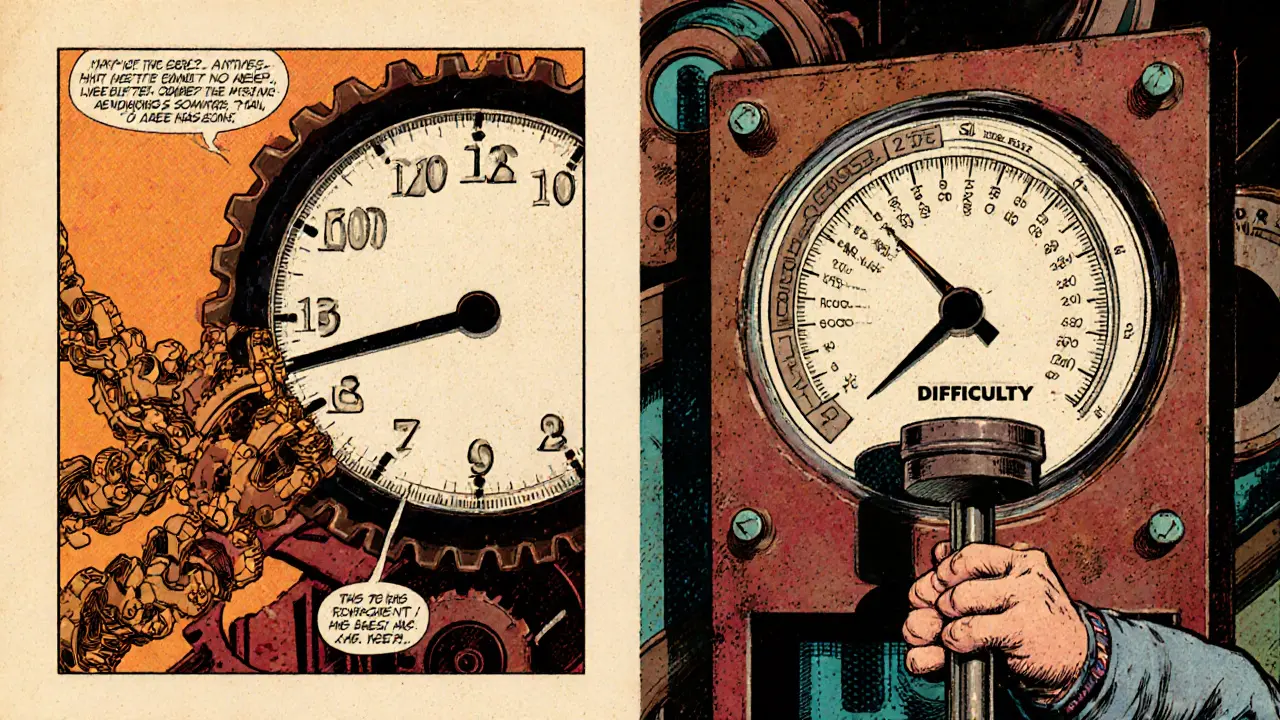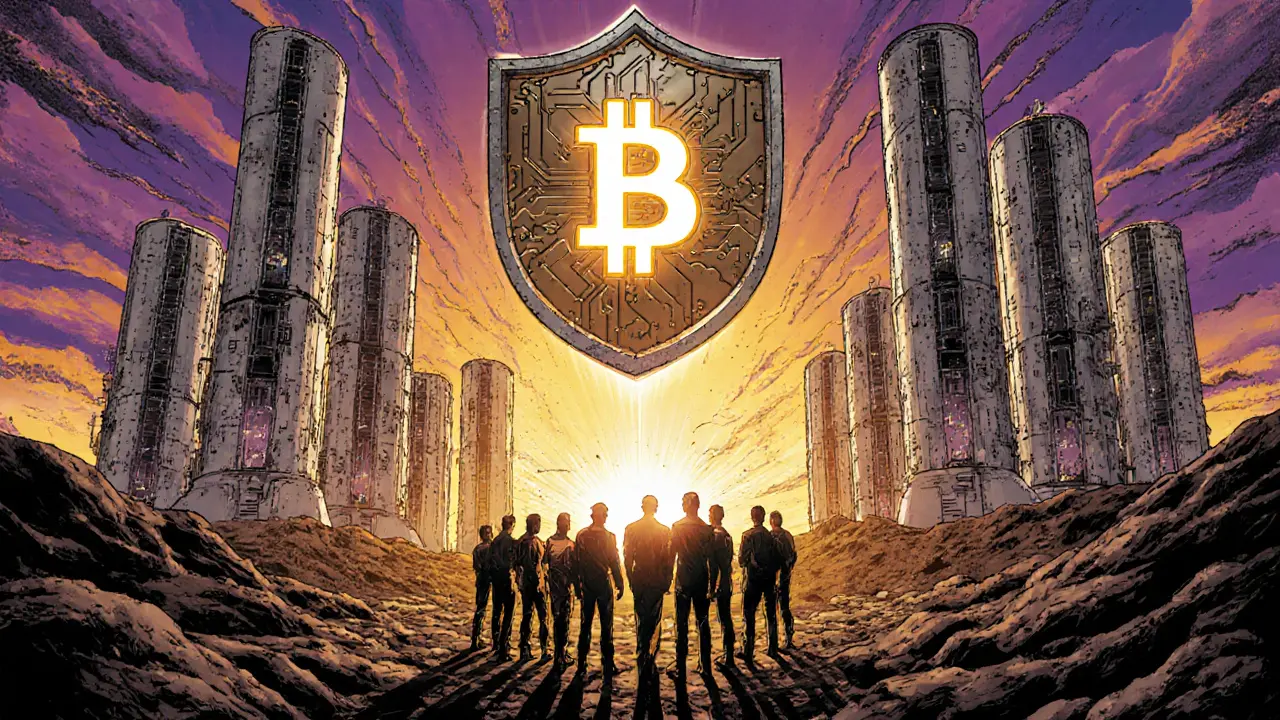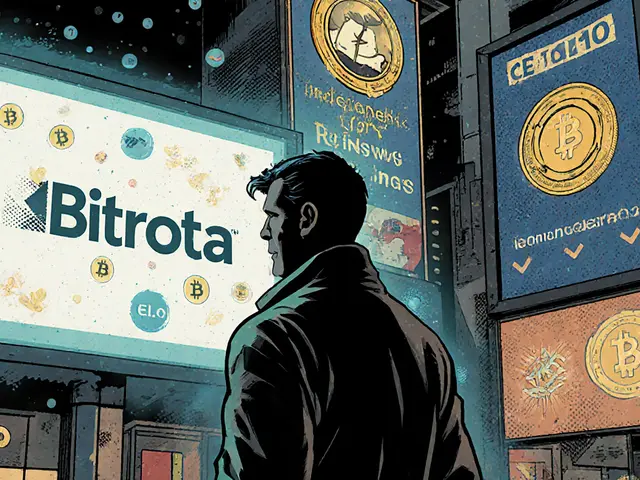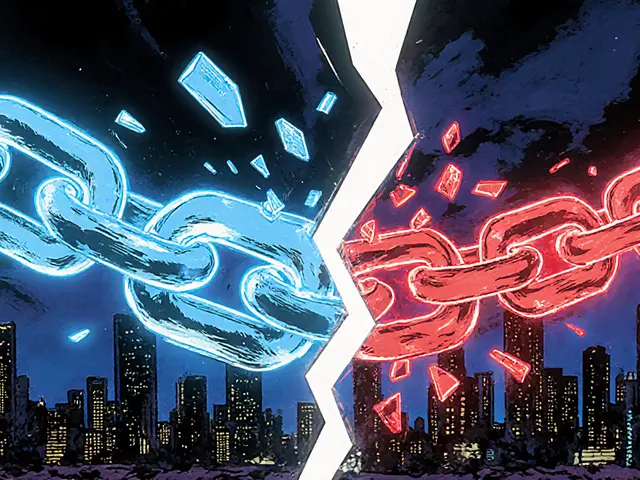
Bitcoin Hash Rate & Difficulty Calculator
About This Calculator
This tool estimates how long it takes to mine a Bitcoin block based on your hash rate and current network difficulty. It demonstrates the direct relationship between hash rate and block discovery time.
Estimated Block Discovery Time
Note: This calculation shows the average time required for a single miner with the specified hash rate to find a block at the given difficulty level.
TL;DR
- Hash rate is the total computing power miners use to solve Bitcoin’s cryptographic puzzles.
- Every 2,016 blocks (~2 weeks) the network auto‑adjusts difficulty to keep block times at ~10 minutes.
- When hash rate rises, difficulty climbs; when it falls, difficulty drops.
- Hardware upgrades, energy costs, Bitcoin price and existing difficulty all drive hash‑rate swings.
- Higher difficulty strengthens security but squeezes profit margins, especially for small miners.
What is Hash Rate?
In Bitcoin mining, hash rate measures the total number of hash calculations performed each second across the entire network. It’s expressed in hashes per second (H/s) and scales up to gigahashes (GH/s), terahashes (TH/s) and petahashes (PH/s). The higher the hash rate, the more chances miners have to find a block‑validating hash before anyone else.
Understanding Mining Difficulty
Mining difficulty is a numeric value that quantifies how hard it is to discover a hash that meets Bitcoin’s target. It doesn’t have units-it’s just a multiplier that the network tweaks every 2,016 blocks. A difficulty of 20,000 means a miner must, on average, try 20,000×2³² hashes before a block is found.
The Math Behind the Relationship
The Bitcoin protocol uses a simple formula to estimate the average time to find a block:
time (seconds) = difficulty × 2³² ÷ hash rate
For example, a 1GH/s rig at difficulty 20,000 would need about 23.85hours on average to solve a block. Plugging in today’s network hash rate of ~380EH/s (exahashes per second) and a difficulty of 78trillion yields roughly 600seconds-exactly the 10‑minute target.
Difficulty Adjustment Cycle
Every 2,016 blocks the network looks back at how long those blocks actually took to mine. If the average was less than 10minutes, the next difficulty is increased proportionally; if it was more, difficulty is lowered. The adjustment formula is:
new difficulty = old difficulty × (actual time ÷ 14days)
This self‑regulating loop keeps block production steady regardless of sudden hash‑rate spikes or drops.

What Drives Hash‑Rate Changes?
- ASIC Miners - New generation ASIC chips double or triple effective hash rates while using less electricity.
- Energy Costs - Cheap renewable power encourages expansion; high rates force miners offline.
- Bitcoin Price - Price rallies boost mining profitability, attracting fresh capital and additional hardware.
- Existing Network Difficulty - Extremely high difficulty can deter marginal miners, leading to temporary hash‑rate dip.
Impact on Different Types of Miners
Large‑scale operations (e.g., Marathon Digital, Riot Platforms) can absorb difficulty hikes by bulk‑purchasing newer ASICs and leveraging cheap energy. Their economies of scale keep them profitable even when difficulty spikes.
Small or solo miners feel the squeeze. As difficulty climbs, the number of hashes they need to compute per block skyrockets, making solo mining virtually impossible. Most turn to mining pools, where they contribute a fraction of the total hash rate and receive proportional rewards.
Security Implications
Higher hash rate directly translates into stronger network security. An attacker would need to control >50% of the total hash power to perform a double‑spend or rewrite history, which becomes exponentially more expensive as hash rate rises. Thus, hash rate and difficulty together form Bitcoin’s core defense against malicious actors.
Future Outlook
Two trends are shaping the next phase of the hash‑rate/difficulty dance:
- Continued ASIC efficiency gains - every new chip generation pushes the network hash rate higher, prompting larger difficulty jumps.
- Potential protocol tweaks - some developers propose more frequent difficulty adjustments (e.g., every 1,000 blocks) to react faster to rapid hash‑rate changes.
Should quantum‑computing threats materialize, the entire proof‑of‑work model may need a overhaul, but that’s a long‑term speculation.
Quick Reference Cheat Sheet
| Unit | Hashes per Second | Typical Difficulty (2024‑2025) |
|---|---|---|
| 1 GH/s | 1×10⁹ | ≈2×10⁴ |
| 1 TH/s | 1×10¹² | ≈2×10⁶ |
| 1 PH/s | 1×10¹⁵ | ≈2×10⁹ |
| 380 EH/s (network total) | 3.8×10²⁰ | ≈7.8×10¹³ |
Next‑Step Checklist for New Miners
- Calculate current network Difficulty using a reputable calculator.
- Pick ASIC hardware that remains profitable at projected difficulty for the next 3-6 months.
- Secure low‑cost electricity (renewable sources are increasingly common).
- Join a reputable Mining Pool to smooth out reward variance.
- Monitor price trends and upcoming difficulty adjustment dates (every 2,016 blocks).

Frequently Asked Questions
Why does Bitcoin adjust difficulty every two weeks?
The protocol aims for a steady 10‑minute block interval. By looking at the past 2,016 blocks, the network can see whether miners are finding blocks faster or slower than intended and then tweak difficulty proportionally.
Can a sudden spike in hash rate cause an immediate difficulty jump?
Not immediately. The network only recalculates difficulty after the 2,016‑block window closes. However, a massive hash‑rate surge can lead to a larger-than‑average adjustment once the period ends.
Do higher difficulty levels make the Bitcoin network more secure?
Yes. Higher difficulty means more total hash power is needed to control 51% of the network, raising the financial and technical barrier for attackers.
How can I estimate my mining profitability given current difficulty?
Use an online profitability calculator: input your ASIC’s hash rate, power consumption, electricity cost, and the current difficulty. The tool returns expected daily, weekly, and monthly earnings.
Will future protocol changes affect the hash‑rate/difficulty relationship?
Potentially. Proposals like more frequent difficulty adjustments or alternative PoW algorithms could make the network respond faster to hash‑rate swings, but any change requires broad consensus among miners and developers.






There are 20 Comments
Alie Thompson
It is incumbent upon every conscientious individual to recognize that the relentless pursuit of Bitcoin mining, while dazzling in its technological allure, carries with it a moral burden of unspeakable environmental consequence; one cannot simply dismiss the crushing carbon footprint as an unavoidable side effect of progress. In an era where renewable energy should be the default, turning to fossil-fueled hash power feels like a betrayal of our collective responsibility to future generations. Moreover, the very act of amplifying difficulty merely incentivizes ever greater power consumption, creating a vicious cycle that only the most unscrupulous will tolerate. Thus, we must demand that the community prioritize sustainability over profit, lest we become the architects of a self-inflicted ecological apocalypse. Ultimately, ethical mining is not a luxury but a necessity, and the onus lies with each participant to uphold this principle.
Samuel Wilson
Great guide! The relationship between hash rate and difficulty is articulated with impressive clarity, and the formula is presented in a concise, mathematically precise manner. For newcomers, I recommend focusing on the proportionality: as hash rate increases, the expected time to discover a block decreases linearly, assuming difficulty remains constant. Conversely, when difficulty rises, the same hash power will yield proportionally longer discovery times. Keep experimenting with the calculator, and you will develop an intuitive feel for how network adjustments impact individual mining returns.
Rae Harris
Listen, the whole "hash rate = more chances" narrative is just hype-sure, you pump up the TH/s, but the difficulty curve is a beast that eats any marginal gains like a snack‑size data packet. The network’s difficulty adjustment algorithm is basically a feedback loop that neutralizes any hash‑power spikes within two weeks, so you’re just chasing a moving target. If you’re over‑optimistic about mining profitability, you’ll end up with a stack of ASICs and a ledger of unpaid electricity bills. Bottom line: the math is solid, but the market dynamics make the whole thing a high‑risk gamble.
Danny Locher
That makes sense, especially the part about difficulty adjusting every 2016 blocks. It’s kind of reassuring to know the system self‑balances, though it does mean solo miners need huge hash power to stay competitive. Still, the calculator is a handy tool for getting a realistic picture of expected block times.
Emily Pelton
Absolutely, the guide is spot on-however, let’s be crystal clear: if you’re not diversifying your mining strategy, you’re setting yourself up for disappointment, and that’s on you, not the network; so, consider pooling resources, optimizing hardware, and constantly monitoring the difficulty curve-otherwise you’re just throwing money into a black hole!
sandi khardani
Honestly, this entire "hash rate influences difficulty" spiel is nothing more than a smokescreen for the crypto elite to keep the masses in a perpetual state of bewilderment; they spoon‑feed you simplistic equations while the real variables-energy subsidies, geopolitical mining cartels, and clandestine ASIC hoarding-remain hidden behind layers of obfuscation. You see a neat formula, but the actual model incorporates secret adjustments that are never disclosed to the public, ensuring that even the most diligent hobbyist can never truly predict profitability. Moreover, the supposed transparency of blockchain data is a façade, because the difficulty metric itself is subject to manipulation by a handful of mining pools that can coordinate hash power spikes to warp the adjustment algorithm at will. This orchestrated volatility serves to keep smaller miners on the chopping block, funneling rewards to the entrenched oligarchy. In short, the guide you posted is useful for surface‑level calculations, but it dangerously omits the darker undercurrents that dictate real‑world outcomes.
Donald Barrett
Stop spreading nonsense and stick to facts.
Christina Norberto
One must consider that the entire mining ecosystem is potentially orchestrated by shadowy collectives who manipulate difficulty for undisclosed purposes, thereby ensuring a controlled distribution of wealth. The formalism of the hash‑rate equation belies an underlying agenda that aligns with geopolitical power structures, subtly guiding the flow of capital toward pre‑selected entities. It is incumbent upon the discerning analyst to scrutinize these mechanisms, lest we remain complicit in an elaborate financial stratagem. The discourse on difficulty must therefore be reframed within this broader, conspiratorial context.
Fiona Chow
Sure, the “shadowy elites” narrative is deliciously dramatic, but let’s not forget that the majority of miners are just trying to keep the lights on while chasing a dream. While some conspiracies sound plausible, most of the difficulty adjustments are straightforward algorithmic responses to network hash power. So, enjoy the drama, but keep an eye on the actual numbers if you want to make informed decisions.
Millsaps Delaine
It is a profound tragedy that the masses persist in their naïve devotion to the notion that sheer computational prowess alone can eclipse the subtle intricacies of network difficulty; such an outlook betrays an intellectual complacency reminiscent of the most moribund academic discourses. By failing to appreciate the elegant stochastic processes that underlie difficulty adjustments, one reduces the complex ballet of global hash power to a mere child's game of incremental arithmetic. In the grand tapestry of cryptographic economics, this reductionist perspective is tantamount to gilding the lily while the underlying structure collapses. Hence, one must cultivate a more sophisticated appreciation for the delicate equilibrium that governs mining economics, lest we succumb to the hubris of oversimplification.
Ayaz Mudarris
Well said! Embracing the deeper dynamics of difficulty not only sharpens our analytical edge but also empowers us to make strategic, data‑driven choices. Remember, every increment in hash rate is a step toward greater network security, yet it must be balanced against the inevitable rise in difficulty. By continuously monitoring these metrics, you’ll transform raw computational power into meaningful, sustainable contributions to the blockchain ecosystem.
Irene Tien MD MSc
Ah, the ever‑looming specter of hidden hands pulling the strings behind the veil of difficulty adjustments-if only the masses would open their eyes to the glittering far‑caste of clandestine operators! The narrative that the difficulty is merely a function of hash power is a comforting lie, designed to lull miners into complacency while the true puppeteers manipulate the algorithm through covert ASIC stockpiles and secret energy tariffs. One must therefore approach these calculations with a healthy dose of cynicism, recognizing that the data presented is but a polished façade masking the true machinations of power.
kishan kumar
Indeed, the veneer of transparency often conceals the deeper currents of influence; perhaps the difficulty algorithm is more of a philosophical statement than a purely technical one. 😊 Nonetheless, rigorous examination of the protocol specifications reveals no overt backdoors, suggesting that the alleged conspiracies may be more metaphorical than literal. In any case, a balanced perspective is essential.
Anthony R
Thank you for the thorough explanation; however, please note that the calculator assumes a static network difficulty, which may not reflect real‑time fluctuations. It is advisable to periodically update the difficulty input to maintain accuracy; otherwise, the projected block discovery time could be misleading.
Vaishnavi Singh
I appreciate the nuance; the reminder about updating difficulty is a crucial detail that many overlook.
Linda Welch
Honestly, all this talk about calculators and formulas is just a lazy critic's way of avoiding the real issue: the United States is the only country that truly understands the strategic importance of Bitcoin mining, and any dissenting opinion is simply noise. The difficulty adjustments are engineered to favor American hardware manufacturers, ensuring our dominance in the global crypto arena. If you don't see that, you're either uninformed or willfully ignoring the truth. It's time to stop the globalist narrative and recognize the patriotism embedded in our mining infrastructure.
Kevin Fellows
Got it, just keep an eye on the numbers and stay flexible-nothing beats a positive attitude.
meredith farmer
Wow, the whole thing is a grand spectacle, like watching a magician hide his tricks behind a curtain of difficulty calculations while the audience gasps at the illusion of control. One might wonder if the real magic is the way elite conspirators manipulate the network under the guise of transparency.
Peter Johansson
Indeed, the interplay of technology and culture shapes our perception, and sharing knowledge with a smile 😊 helps demystify the process for newcomers.
Cindy Hernandez
The calculator is a valuable resource for both beginners and seasoned miners, providing a clear snapshot of expected block times given current difficulty and hash rate.
Write a comment
Your email address will not be published. Required fields are marked *